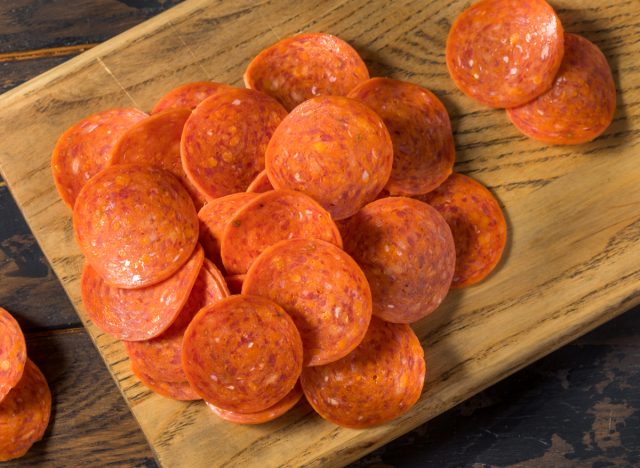10 Unhealthiest Proteins To Avoid, According to Dietitians

Protein, protein, protein….we’re constantly reading about ways to get enough, how much to eat for weight loss, or making sure you’re consuming the right amount to build muscle. Options can be from plant sources like beans, soybeans, and lentils or from animal sources like chicken, fish, and beef. But like all foods, there are healthier options and not-so-healthy options based on the array of nutrients the protein food contains.
When it comes to unhealthy protein, you’ll still get some good-for-you nutrients like protein and zinc. However, the landmine with unhealthy options tends to be high in saturated fat and sodium which, regular consumption, can increase your risk for cardiovascular disease, type 2 diabetes, and certain forms of cancer. But not all unhealthy protein options are unhealthy for that reason.
Below you’ll find 10 protein options that shouldn’t be a regular part of your healthy eating plan. That doesn’t mean you should avoid them at all costs—as all foods can fit into a healthy eating plan. But it does mean that you could select healthier versions of the food, or eat the real deal only once in a while. Take a look at the list below to find out how to enjoy your favorite “unhealthy” proteins in a healthy way. Read on, and for more, don’t miss 13 Unhealthiest Carbs To Stay Away From.
Bologna

Deli meats are a go-to easy lunch or dinner option, but it may be one you want to minimize in your healthy eating plan. One slice (33 grams) of bologna provides 92.7 calories, 2.44 g of saturated fat, and 455 milligrams of sodium. But when you’re preparing your bologna sandwich, you use four, five, or even six (or more!) slices of this overly processed meat. If you’re hitting the deli counter, sliced ham and turkey are better options that are lower in saturated fat. You can find lower sodium versions too at many markets.
Bratwurst

Bratwurst is a beloved German sausage—but Bratwurst lovers beware! One link (85 grams) of pork Bratwurst provides 283 calories, 8.5 grams of saturated fat, and 719 milligrams of sodium. Once again, you’re seeing overly processed meats resulting in products that are just too high in artery-clogging saturated fat and heart-harming sodium. If you’re craving a Bratwurst, save it for a once-in-a-blue-moon treat.
Pork Belly

According to Elizabeth Shaw, MS, RDN, CPT, national nutrition expert and author of the For Dummies Instant Pot Cookbook and Air Fryer Cookbook, “While I would never say any food is off limits (you can find a place for everything you truly enjoy in a balanced diet), I’d recommend limiting consumption of pork belly for in just a 3-ounce portion you’ll get 242 calories and 7 grams of saturated fat.” High intakes of saturated fat have been linked to cardiovascular disease and frequent consumption of foods high in saturated fat may put you at higher risk. If you enjoy pork belly Shaw recommends eating a smaller portion in conjunction with other nutrient-rich, high-fiber foods, like vegetables and beans.
Hot Dogs

Although they have become a national symbol of baseball games, traditional hot dogs are brimming with saturated fat and calories. In addition, consuming processed meats like hot dogs on a regular basis can increase your risk of cardiovascular disease. One Hebrew National Hot Dog provides 25 grams of saturated fat and 480 milligrams sodium, which is 25% and 21% of the daily recommended maximums, respectively. Further, hot dogs contain nitrites and nitrates which have been linked to certain forms of cancer and some folks choose to avoid it. If you’re craving a hot dog, there are many better-for-you brands made with lower-fat meats (like turkey and chicken) and are nitrite- and nitrate-free.
Hard Salami

Four ounces of hard pork salami provides 460 calories, 13.4 grams of saturated fat, and 2,550 milligrams of sodium. That’s 61% of the daily recommended maximum of saturated fat and 111% of the daily recommended maximum of sodium! If you’re really craving some hard salami, minimize portions to one ounce and enjoy it on occasion.
Swordfish

The Food and Drug Administration (FDA) recommends eating 8 ounces of seafood weekly. “As much as I want people to consume seafood at least twice a week to reap the omega-3 fatty acid benefits, I also want people to use caution when selecting their seafood choices as not all are created equal,” explains Shaw. For example, swordfish is one of the highest mercury choices of seafood with 0.995 ppm. The FDA recommends that pregnant or breastfeeding women should consume between 8 and 12 ounces per week of a variety of seafood from choices that are lower in mercury. “Consuming high levels of mercury may have adverse health effects and may affect the brain. This has raised concerns over mercury intakes and disease states such as Parkinson’s, Alzehemiers, and anxiety,” Shaw says. “Instead of neglecting seafood altogether, choose lower mercury options like salmon or shrimp.”
Plant-Based ‘Meat’ Replacements

Whether it’s sausages, burgers, or other plant-based “meat” replacements, if you look at some of the nutrition facts panels it’s anything but healthy. Some of these plant-based options are very high in sodium and shouldn’t be an everyday choice in your healthy eating plan. If you enjoy plant-based “meat” replacements, read the nutrition facts panel to make sure it’s still a healthy choice.
Pepperoni

Three ounces of sliced beef and pork pepperoni provide 428 calories, 15 grams of saturated fat, and 1,340 milligrams of sodium. Most also contain nitrites and nitrates, which are used to help increase shelf-life and minimize microbial growth. However, as mentioned above, regular consumption of foods containing nitrites and nitrates may be linked to certain forms of cancer. If you’re a pepperoni-lover, look for better-for-you choices that are lower in calories and saturated fat. There are also brands that sell nitrite- and nitrate-free if you choose.
Sausage

One link (101 grams) of Italian pork sausage provides 293 calories, 8.71 grams of saturated fat, and 569 milligrams of sodium. Once again, this highly processed meat is an unhealthy protein that is higher in calories, saturated fat, and sodium than you really want on a regular basis. If you love sausage as part of your eating plan, there are many healthier options that are lower in these not-so-healthy nutrients that you can find on market shelves.
Spam

One of the unhealthiest proteins is Spam, and it’s easy to see why once you know that 2 ounces of original Spam contain 180 calories, 6 grams of saturated fat, and 790 milligrams of sodium. Based on a 2,000-calorie diet that is 30% of saturated fat and 34% of sodium recommended maximum per day. Wan Na Chun, MPH, RD, CPT of One Pot Wellness explains that regular consumption of foods high in saturated fat and sodium can increase the risk of chronic diseases such as high blood pressure, heart disease, and stroke. If you are craving this shelf-stable option, Spam Lite is available with less fat, sodium, and calories.
- Source: https://fdc.nal.usda.gov/fdc-app.html#/food-details/171637/nutrients
- Source: https://fdc.nal.usda.gov/fdc-app.html#/food-details/171620/nutrients
- Source: https://fdc.nal.usda.gov/fdc-app.html#/food-details/2341307/nutrients
- Source: https://fdc.nal.usda.gov/fdc-app.html#/food-details/172938/nutrients
- Source: https://www.fda.gov/media/102331/download#:~:text=The%20Dietary%20Guidelines%20for%20Americans%20recommends%3A&text=At%20least%208%20ounces%20of,on%20a%202%2C000%20calorie%20diet.&text=Those%20who%20are%20pregnant%20or%20breastfeeding%20consume%20between%208%20and,that%20are%20lower%20in%20mercury.
- Source: https://www.fda.gov/food/environmental-contaminants-food/mercury-levels-commercial-fish-and-shellfish-1990-2012
- Source: https://pubmed.ncbi.nlm.nih.gov/21783611/
- Source: https://fdc.nal.usda.gov/fdc-app.html#/food-details/174575/nutrients
- Source: https://fdc.nal.usda.gov/fdc-app.html#/food-details/171631/nutrients